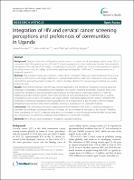| dc.identifier.citation | Kumakech, E., Andersson, S., Wabinga, H., & Berggren, V. (2015). Integration of HIV and cervical cancer screening perceptions and preferences of communities in Uganda. BMC women's health, 15(1), 1-13. | en_US |
| dc.description.abstract | Background: Despite the fact that HIV-positive women carry an increased risk of developing cervical cancer (CC) in
comparison with HIV-negative women, HIV and CC screening programs in many developing countries have remained
unintegrated. The objective of this study is to explore perceptions and preferences of community members in Uganda,
including women, men, and village health teams, regarding the integration of HIV and CC screening services in a
single-visit approach.
Methods: This qualitative study was conducted in three districts in Uganda. Data were collected through focus group
discussions with women and village health teams, and individual interviews with men. Respondents were purposely
selected from among those linked to three CC clinics in the three districts. The content analysis method was used to
analyze the data.
Results: Three themes emerged from the data, namely appreciating the benefits of integration, worrying about the
challenges of integration, and preferences for integration. The women endorsed the benefits. However, there were
worries that integration would prolong the waiting time at the health facility and induce tiredness in both the
healthcare providers and the women. There were also fears of being found positive for both HIV and CC and the
consequences such as stress, self-isolation, and social conflicts. Participants, particularly the women, considered the
challenges of screening integration to be manageable by, for example, taking a day off work to visit the hospital,
delegating house chores to other family members, or taking a packed lunch on visiting the hospital.
Conclusions: The community members in Uganda perceive the benefits of HIV and CC screening integration to
outweigh the challenges, and expect that the challenges can be minimized or managed by the women. Therefore,
when considering HIV and CC screening integration, it is important to not only recognize the benefits but also take
into consideration the perceived challenges and preferences of community members. | en_US |

